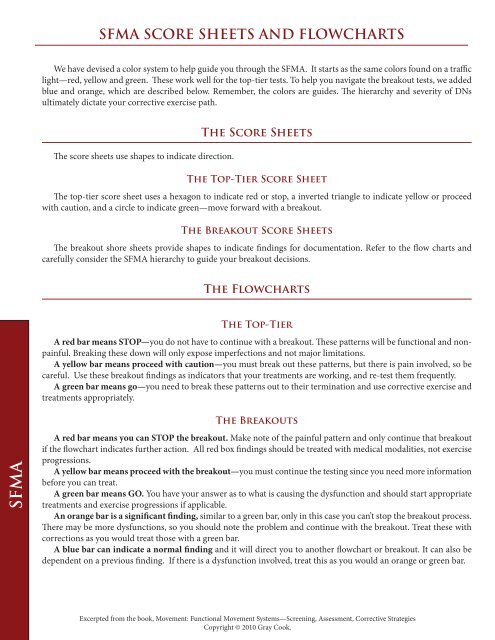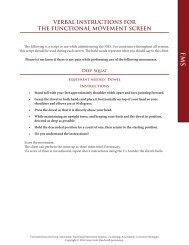SFMA SCORE SHEETS AND FLOWCHARTS - Gray Cook Movement
SFMA SCORE SHEETS AND FLOWCHARTS - Gray Cook Movement
SFMA SCORE SHEETS AND FLOWCHARTS - Gray Cook Movement
Create successful ePaper yourself
Turn your PDF publications into a flip-book with our unique Google optimized e-Paper software.
<strong>SFMA</strong><br />
<strong>SFMA</strong> <strong>SCORE</strong> <strong>SHEETS</strong> <strong>AND</strong> <strong>FLOWCHARTS</strong><br />
We have devised a color system to help guide you through the <strong>SFMA</strong>. It starts as the same colors found on a traffic<br />
light—red, yellow and green. These work well for the top-tier tests. To help you navigate the breakout tests, we added<br />
blue and orange, which are described below. Remember, the colors are guides. The hierarchy and severity of DNs<br />
ultimately dictate your corrective exercise path.<br />
The score sheets use shapes to indicate direction.<br />
The Score Sheets<br />
The Top-Tier Score Sheet<br />
The top-tier score sheet uses a hexagon to indicate red or stop, a inverted triangle to indicate yellow or proceed<br />
with caution, and a circle to indicate green—move forward with a breakout.<br />
The Breakout Score Sheets<br />
The breakout shore sheets provide shapes to indicate findings for documentation. Refer to the flow charts and<br />
carefully consider the <strong>SFMA</strong> hierarchy to guide your breakout decisions.<br />
The Flowcharts<br />
The Top-Tier<br />
A red bar means STOP—you do not have to continue with a breakout. These patterns will be functional and nonpainful.<br />
Breaking these down will only expose imperfections and not major limitations.<br />
A yellow bar means proceed with caution—you must break out these patterns, but there is pain involved, so be<br />
careful. Use these breakout findings as indicators that your treatments are working, and re-test them frequently.<br />
A green bar means go—you need to break these patterns out to their termination and use corrective exercise and<br />
treatments appropriately.<br />
The Breakouts<br />
A red bar means you can STOP the breakout. Make note of the painful pattern and only continue that breakout<br />
if the flowchart indicates further action. All red box findings should be treated with medical modalities, not exercise<br />
progressions.<br />
A yellow bar means proceed with the breakout—you must continue the testing since you need more information<br />
before you can treat.<br />
A green bar means GO. You have your answer as to what is causing the dysfunction and should start appropriate<br />
treatments and exercise progressions if applicable.<br />
An orange bar is a significant finding, similar to a green bar, only in this case you can’t stop the breakout process.<br />
There may be more dysfunctions, so you should note the problem and continue with the breakout. Treat these with<br />
corrections as you would treat those with a green bar.<br />
A blue bar can indicate a normal finding and it will direct you to another flowchart or breakout. It can also be<br />
dependent on a previous finding. If there is a dysfunction involved, treat this as you would an orange or green bar.<br />
Excerpted from the book, <strong>Movement</strong>: Functional <strong>Movement</strong> Systems—Screening, Assessment, Corrective Strategies<br />
Copyright © 2010 <strong>Gray</strong> <strong>Cook</strong>.
Cervical Pattern One<br />
Cervical Pattern Two<br />
Cervical Pattern Three<br />
Upper Extremity Pattern One<br />
Upper Extremity Pattern Two<br />
Multi-Segmental Flexion<br />
<strong>SFMA</strong> TOP-TIER ASSESSMENTS<br />
FN FP DP DN<br />
FN FP DP DN<br />
L<br />
R<br />
L<br />
R<br />
L<br />
R<br />
FN FP DP DN<br />
FN FP DP DN<br />
FN FP DP DN<br />
FN FP DP DN<br />
Multi-Segmental Extension<br />
Multi-Segmental Rotation<br />
Single-Leg Stance<br />
Overhead Squat<br />
L<br />
R<br />
FN FP DP DN<br />
Provocation Assessments<br />
Pattern One<br />
Pattern Two<br />
FN FP DP DN<br />
L<br />
R<br />
FN FP DP DN<br />
FN FP DP DN<br />
L<br />
R<br />
FN FP DP DN<br />
FN FP DP DN<br />
Excerpted from the book, <strong>Movement</strong>: Functional <strong>Movement</strong> Systems—Screening, Assessment, Corrective Strategies<br />
Copyright © 2010 <strong>Gray</strong> <strong>Cook</strong>.<br />
L<br />
R<br />
<strong>SFMA</strong>
<strong>SFMA</strong><br />
Cervical Spine Breakout<br />
Active Supine Cervical Flexion (Chin to Chest)<br />
Passive Supine Cervical Flexion<br />
Supine OA Cervical Flexion Test (20˚)<br />
C1-C2 Cervical Rotation Test<br />
L<br />
R<br />
L<br />
R<br />
FN D &/or P<br />
FN D &/or P<br />
FN DN<br />
Active Supine Cervical Rotation (80˚)<br />
L<br />
R<br />
Passive Cervical Rotation<br />
Supine Cervical Extension<br />
L<br />
R<br />
L<br />
R<br />
FP / DP<br />
FN D &/or P<br />
FN D &/or P<br />
FN DN FP / DP<br />
FN DN FP / DP<br />
Upper Extremity Pattern Breakout<br />
Active Prone Upper Extremity Pattern<br />
FN<br />
Passive Prone Upper Extremity Patterns<br />
L<br />
R<br />
Supine Reciprocal Upper Extremity Pattern<br />
L<br />
R<br />
FN DN<br />
FN DN<br />
Excerpted from the book, <strong>Movement</strong>: Functional <strong>Movement</strong> Systems—Screening, Assessment, Corrective Strategies<br />
Copyright © 2010 <strong>Gray</strong> <strong>Cook</strong>.<br />
L<br />
R<br />
D &/or P<br />
FP / DP<br />
FP / DP
Multi-Segmental Flexion Breakout<br />
Single-Leg Forward Bend<br />
Long-Sitting Toe Touch<br />
Active Straight-Leg Raise<br />
Passive Straight-Leg Raise<br />
L<br />
R<br />
Bilat FN<br />
Rolling—FN ____ DN ____ DP____ FP ____<br />
Supine Knee-to-Chest Holding Thighs<br />
Prone Rocking<br />
L<br />
R<br />
Bilat FN Bilat D/P Unilat D/P<br />
FN<br />
Toe Touch<br />
DP<br />
Touch<br />
NSA<br />
Touches<br />
Ltd SA<br />
Rolling—FN ____ DN ____ DP____ FP ____<br />
L<br />
R<br />
FN<br />
FN<br />
10 > ASLR<br />
DP<br />
Touches<br />
Ltd SA<br />
L<br />
R<br />
D (
<strong>SFMA</strong><br />
Multi-Segmental Extension Breakout<br />
Single-Leg Hip Extension<br />
Prone Active Hip Extension (10 0 )<br />
Prone Passive Hip Extension<br />
Modified Thomas Test<br />
Unilateral Shoulder Backward Bend<br />
L<br />
R<br />
Supine Lat Hips Flexed Test<br />
L<br />
R<br />
Bilat >10 Bilat D/P Unilat D/P<br />
L<br />
R<br />
L<br />
R<br />
Knee<br />
Strght<br />
Touch<br />
L<br />
R<br />
L<br />
R<br />
FN<br />
25% > Active<br />
Hip<br />
Abd<br />
Touch<br />
FN<br />
FN<br />
Never<br />
Touch<br />
FP, DP, DN<br />
D &/or P<br />
Rolling—FN ____ DN ____ DP____ FP ____<br />
FABER<br />
L<br />
R<br />
FN DN<br />
FP or DP<br />
Abd &<br />
Strght<br />
Touch FN<br />
D &/or P<br />
D &/or P<br />
Rolling—FN ____ DN ____ DP____ FP ____<br />
DP/<br />
FP<br />
Multi-Segmental Extension Breakout<br />
Supine Lat Hips Extended<br />
Lumbar Locked Unilateral Ext. (ER) 120 0<br />
Bilat FN Bilat D/P Unilat D/P<br />
Multi-Segmental Rotation Breakout<br />
Seated Rotation<br />
Lumbar Locked Unilateral Rotation<br />
L<br />
R<br />
L<br />
R<br />
L<br />
R<br />
FN Improves No Change<br />
Lumbar Locked Unilateral Ext. (IR) 50 0<br />
L<br />
R<br />
> 45 Bilateral<br />
Switched<br />
FN<br />
DN, DP, FP<br />
FP/DP<br />
Lumbar Locked Passive Unilateral Ext. (IR) 50 0<br />
L<br />
R<br />
FN<br />
Bilat<br />
DN Uni DN<br />
D &/or P<br />
L<br />
R<br />
FP/DP<br />
Lumbar Locked Passive Unilateral Ext. (IR) 50 0<br />
L<br />
R<br />
FN Bi. DN Uni. DN<br />
FN<br />
Rolling—FN ____ DN ____ DP____ FP ____<br />
Excerpted from the book, <strong>Movement</strong>: Functional <strong>Movement</strong> Systems—Screening, Assessment, Corrective Strategies<br />
Copyright © 2010 <strong>Gray</strong> <strong>Cook</strong>.<br />
FP/DP
Multi-Segmental Rotation Breakout<br />
Prone-on-Elbow Rotation (30)<br />
Asymm Bilat DN FN<br />
Seated Active External Hip Rotation 40 0<br />
Seated Passive External Hip Rotation<br />
Prone Active External Hip Rotation 40 0<br />
L<br />
R<br />
L<br />
R<br />
L<br />
R<br />
FN D &/or P<br />
FN DP/FP<br />
FP/DP<br />
Rolling—FN ____ DN ____ DP____ FP ____<br />
Prone Passive External Hip Rotation<br />
L<br />
R<br />
DN<br />
FN D &/or P<br />
DP/FP DN<br />
FN<br />
Rolling—FN ____ DN ____ DP____ FP ____<br />
L<br />
R<br />
Multi-Segmental Rotation Breakout<br />
Seated Active Internal Hip Rotation 30 0<br />
Seated Passive Internal Hip Rotation<br />
Prone Active Internal Hip Rotation 30 0<br />
FN D &/or P<br />
Prone Passive Internal Hip Rotation<br />
L<br />
R<br />
L<br />
R<br />
L<br />
R<br />
L<br />
R<br />
FN D &/or P<br />
Seated Active External Tibial Rotation 20 0<br />
L<br />
R<br />
FN DP/FP DN<br />
DP/FP DN FN<br />
Rolling—FN ____ DN ____ DP____ FP ____<br />
FN D &/or P<br />
Seated Passive External Tibial Rotation<br />
L<br />
R<br />
FN DP/FP DN<br />
Excerpted from the book, <strong>Movement</strong>: Functional <strong>Movement</strong> Systems—Screening, Assessment, Corrective Strategies<br />
Copyright © 2010 <strong>Gray</strong> <strong>Cook</strong>.<br />
<strong>SFMA</strong>
<strong>SFMA</strong><br />
Multi-Segmental Rotation Breakout<br />
Seated Active Internal Tibial Rotation 200 Seated Passive Internal Tibial Rotation<br />
L<br />
R<br />
Single-Leg Stance Breakout<br />
Vestibular Shake Test<br />
L<br />
R<br />
Half-Kneeling Narrow Base<br />
L<br />
R<br />
L<br />
R<br />
L<br />
R<br />
FN D &/or P<br />
FN DP/FP DN<br />
FN D &/or P<br />
FN DN, DP, FP<br />
Rolling—FN ____ DN ____ DP____ FP ____<br />
Quadruped Diagonals<br />
Heel Walks<br />
L<br />
R<br />
L<br />
R<br />
FN DP or FP<br />
DN<br />
FN D &/or P<br />
Prone Passive Dorsifl—FN ___ DN ___ DP/FP ___<br />
Toe Walks<br />
FN<br />
D &/or P<br />
Prone Passive Plantar—FN ___ DN ___ DP/FP ___<br />
Single-Leg Stance Breakout<br />
Seated Ankle Inversion/Eversion<br />
Overhead Deep Squat Breakout<br />
Fingers Interlocked Behind Head<br />
Assisted Deep Squat<br />
Half Kneeling Dorsiflexion<br />
L<br />
R<br />
Can’t<br />
Evrt<br />
Can’t<br />
Invrt<br />
DP/FP<br />
Supine Knee to Chest Holding Shins<br />
Supine Knee to Chest Holding Thighs<br />
L<br />
R<br />
L<br />
R<br />
L<br />
R<br />
FN<br />
FN D &/or P<br />
FN D &/or P<br />
FN D &/or P<br />
FN D &/or P<br />
FN DN FP/DP<br />
Excerpted from the book, <strong>Movement</strong>: Functional <strong>Movement</strong> Systems—Screening, Assessment, Corrective Strategies<br />
Copyright © 2010 <strong>Gray</strong> <strong>Cook</strong>.<br />
Both<br />
DN




